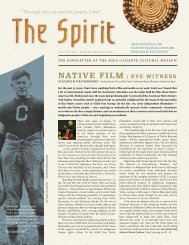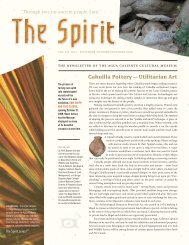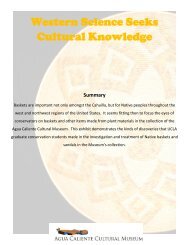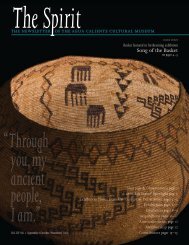Create successful ePaper yourself
Turn your PDF publications into a flip-book with our unique Google optimized e-Paper software.
Bathhouse #3: 1930s<br />
The bathhouse was rebuilt again in the 1930s with funds obtained<br />
from a recent airport lease on Section 14. In its updated form, the<br />
bathhouse began drawing such Hollywood notables as Dolores Del Rio,<br />
Robert Taylor, Bruce Cabot, Ralph Belamy, and Charles Farrell; the stars in<br />
turn attracted the attention of the editor of the March of Time news<br />
movies, who sent a photographer to film the bathhouse. The <strong>Agua</strong> <strong>Caliente</strong><br />
<strong>Hot</strong> <strong>Spring</strong>, and the city which grew up around it, had become famous.<br />
Despite (or possibly due to) the financial success of the bathhouse,<br />
the 1930s marked an all-time low for tribal sovereignty. Having managed<br />
the bathhouse enterprise for more than thirty years, tribal leaders began<br />
making business decisions that were at odds with the non-Indian<br />
community, such as the raising of Indian Canyon and bathhouse entrance<br />
fees. Such decisions incensed non-Indian business owners who felt that<br />
<strong>Agua</strong> <strong>Caliente</strong> bathhouse, circa 1930s<br />
increased fees negatively impacted their own businesses; they demanded that federal authorities intervene to solve<br />
what they called “the Indian problem.”<br />
The federal government responded by taking control of the <strong>Agua</strong> <strong>Caliente</strong> Indian Reservation and its business<br />
enterprises and later arrested tribal leaders on November 20, 1937. Fees were forcibly reduced to their pre-1937 levels –<br />
temporarily.<br />
Tribal member Clemente Segundo traveled to Washington D.C. to expose these actions, which were later<br />
criticized as an over-stepping of federal authority. Addressing the House of Representative’s Committee on Indian<br />
Affairs, Clemente described a collusion of interests between federal officials and the Palm <strong>Spring</strong>s Chamber of<br />
Commerce that had given rise to these events. Control of the reservation was returned to tribe some time later.<br />
bathhouse.<br />
The third and final bathhouse was destroyed in 1957 to make way for the next incarnation of the tribal











